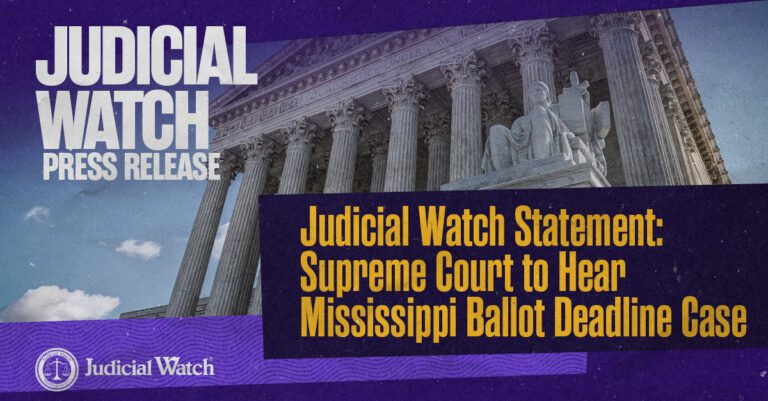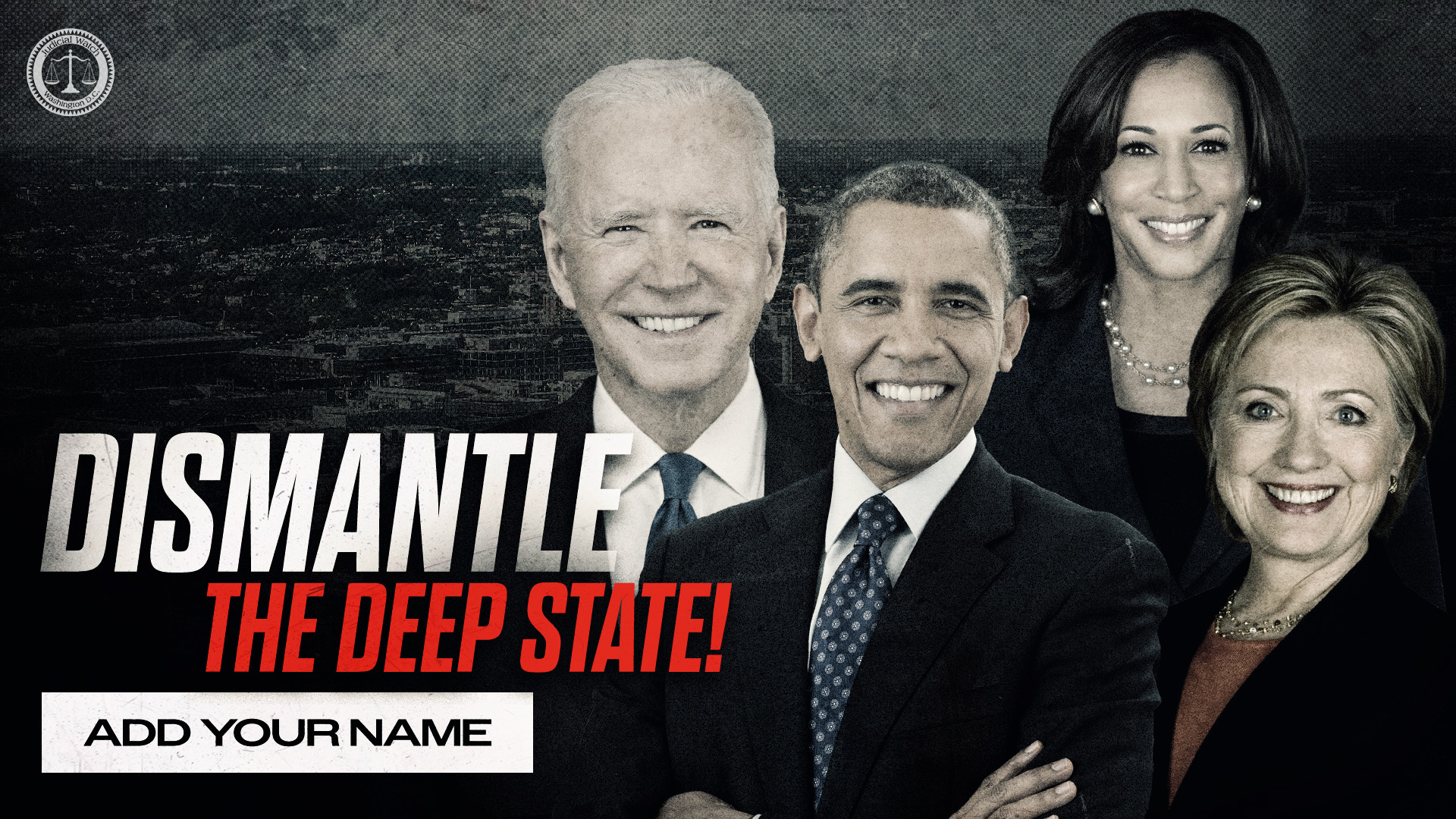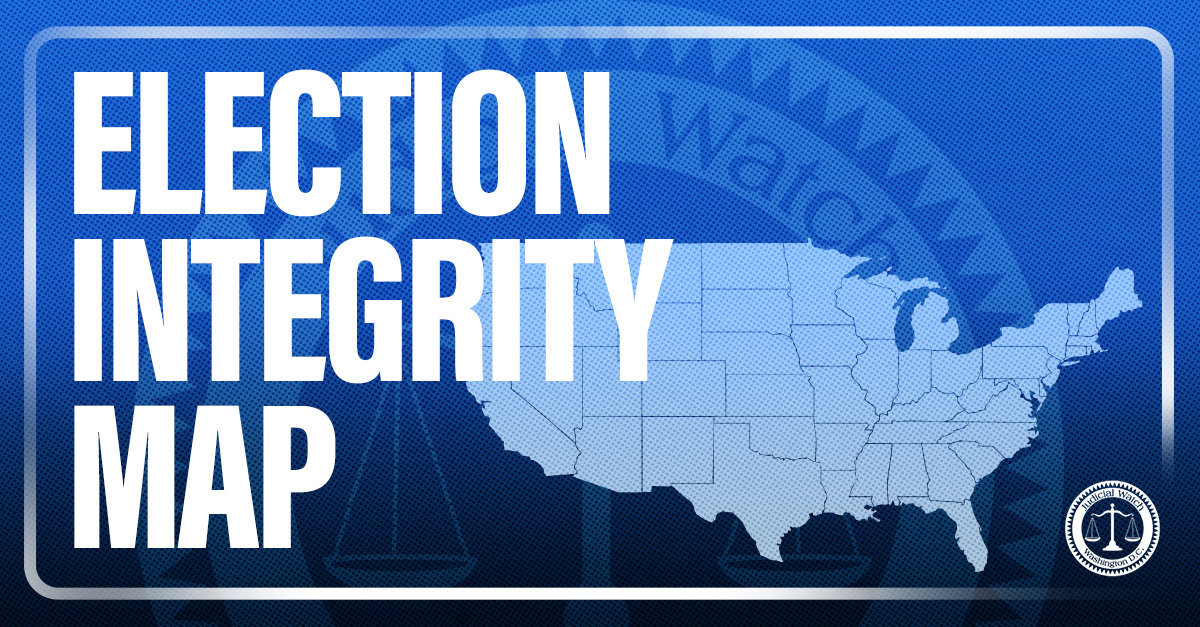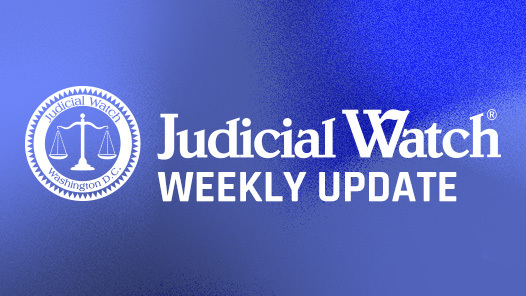
Fauci Agency Cover-Up Exposed
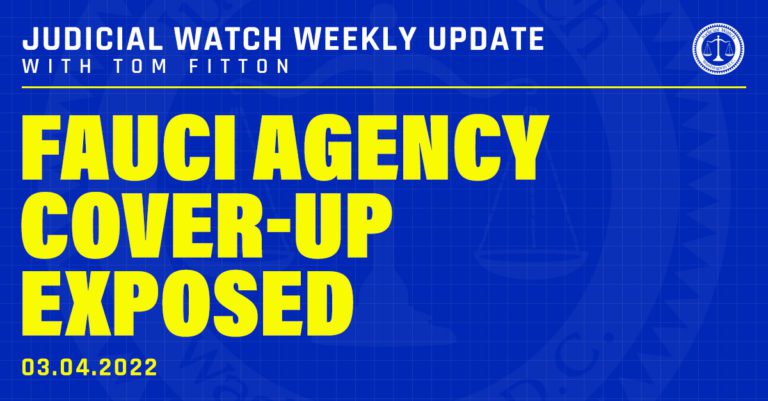
China Failed to Provide Key COVID Info, Fauci Agency Records Show
Judicial Watch Sues Court Officials for Firing Magistrate After She Made Public Comment about Wrongdoing Tied to Murder
The Clintons’ Russia-Ukraine Grift
China Failed to Provide Key COVID Info, Fauci Agency Records Show
China has been accused of obstructing investigations into the origins of the COVID virus, and we can now add another piece to that puzzle.
We received 90 pages of records from the Department of Health and Human Services (HHS) that show the State Department and Dr. Anthony Fauci’s agency, the U.S. National Institute of Allergy and Infectious Diseases (NIAID), knew immediately in January 2020 that China was withholding COVID data, and this was hindering risk assessment and response by public health officials.
The records also show that, nearly two years before the coronavirus outbreak, the U.S. National Institutes of Health (NIH) sent “experts” from the NIH-supported P4 lab at the University of Texas Medical Branch to train Wuhan Institute of Virology lab technicians in lab management and maintenance due to the Wuhan lab’s shortage of trained staff. The same April 2018 cable noted that an official from EcoHealth Alliance “plans to visit Wuhan to meet with Shi [Zhengli].”
We obtained the records through our Freedom of Information Act (FOIA) lawsuit for records of communications, contracts and agreements with the Wuhan Institute of Virology (Judicial Watch, Inc. v. U.S. Department of Health and Human Services (No. 1:21-cv-00696)). The lawsuit specifically sought records about NIH grants that benefitted the Wuhan Institute of Virology.
The novel coronavirus outbreak began in Wuhan, China, in December 2019.
After the outbreak, on January 8, 2020, Dr. Ping Chen, who had been NIAID’s top official in China, emails senior NIAID colleagues Gray Handley, Erik Stemmy, Gayle Bernabe, and Barney Graham with the subject line “PRC Response to Pneumonia Cases Shows Increased Transparency Over Past Outbreaks, but Gaps in Epidemiological Data Remain.” Chen writes:
hi, here is the cable from US Embassy Beijing reporting on the pneumonia outbreak in Wuhan, China. It has ruled out SARS, MERS, and flu. [Redacted] confirmed it is viral infection. [Redacted] The cable contains SBU information. So please don’t distribute it widely.
The summary of the cable states:
While PRC officials have released timely and open general information about the outbreak, a lack of epidemiologic data – including an ‘epi curve’ (a summary of dates of onset of illness), characteristics of infected individuals, and other basic epidemiologic information – hinders better risk assessment and response by public health officials. Authorities have also not released information on how they are defining a “case.” Given these gaps in detailed information to-date, and lack of a final confirmed pathogen, the risk to the United States and global health is difficult to assess at this time.
***
As of January 7, the Wuhan Health Commission has reported 59 local cases of pneumonia with unknown cause. (Note: Wuhan, a city of approximately 11 million people, is the capital of Central China’s Hubei Province. End note.) According to the Health Commission, some patients are vendors who work in the Huanan Seafood Market, which also sells live exotic animals, including beaver, snakes, porcupines, and deer.
***
Health officials state there has been no confirmed human-to-human transmission of the disease, and no cases among health workers. Laboratory investigations have ruled out influenza, avian influenza, SARS, MERS, and other common respiratory pathogens, and are awaiting final pathogen results.
***
PRC [People’s Republic of China] officials on December 31, 2019 alerted WHO to the pneumonia outbreak. WHO contacts told Embassy officials that PRC health departments continue to provide information about the outbreak in accordance with WHO’s International Health Regulations (IRR). While China has been forthcoming with standard information, WHO contacts note they have not received more detailed and potentially useful information, such as “epi curves” or other epidemiological data. The flow of official PRC information on this outbreak is limited to that coming from the Wuhan Health Commission and National Health Commission.
On January 30, 2020, Chen forwards to senior NIAID colleagues Gray Handley, Gayle Bernabe, Joyelle Dominique, William Rosa, Tami Lu and Hilary Marsten a cable issued by the U.S. Embassy in Beijing, which provides a detailed situation report on Chinese government responses to the then-fast spreading SARS-CoV-2 virus from across the country. The cable discusses Chinese virus mitigation measures, infection case numbers, travel restrictions, and quarantine measures then taking place in Beijing, Chengdu, Guangzhou, Shanghai, and Shenyang.
In a section discussing “Media/Social Media” reporting on the virus in China, the cable discusses a Global Times article about the “detention” in early January 2020 of eight Chinese residents for spreading “rumors” about the outbreak of the virus:
[An] article in Global Times praised Wuhan residents for “whistle-blowing” on virus outbreak. A top epidemiologist at the Chinese Center for Disease Control and Prevention (CCDC) on Wednesday commended eight residents, who were detained in early January for spreading “rumors” about the outbreak of the novel coronavirus. Zeng Guang, Chief epidemiologist at the CCDC, said those eight residents should be highly regarded as they turned out to be correct about the viral outbreak, even though the information they spread “lacked scientific evidence.” Zeng’s comment followed an article from the Supreme People’s Court of China (SPC) on Tuesday, in which the top court said that the eight Wuhan residents should be “tolerated” and their act of spreading the information, if taken seriously, would have done much good to the public.
On April 15, 2020, an official whose name is redacted sends an email to colleagues labeled “WIV [Wuhan Institute of Virology] Cables,” and writes, “As I am sure you are quite aware at this point the cables ESTH [State Department’s Environment, Science, Technology and Health Section] wrote on the WIV lab and the concerns we had about the findings of the papers on bat coronavirus research have become big news lately.”
An official forwards an email exchange from April 12, 2018, labeled “For your review – Cable on Wuhan Institute of Virology visit.” That email attached a cable titled “China Virus Institute Welcomes More U.S. Cooperation on Global Health Security.” The partially redacted summary of the cable begins:
China’s Wuhan Institute of Virology, a global leader of virus research, is a key partner for the United States in protecting global health security. Its role as operator of the just-launched ‘P4’ lab – the first such lab in China – opens up even more opportunities for expert exchange, especially in light of the lab’s shortage of trained staff.
The cable also mentions that there is also a “U.S. Centers for Disease Control (CDC)-supported [P4 lab] facility in Pune, India,” and that China “plans to stand up a second P4 lab in Harbin.” Harbin is the capital of Heilongjiang province in northeastern China.
The cable notes that Chinese officials, “described the [Wuhan] lab as a ’regional node’ in the global biosafety system and said it would play an emergency response role in an epidemic or pandemic.” It continues, “[E]xperts from the NIH-supported P4 lab at the University of Texas Medical Branch have trained Wuhan lab technicians in lab management and maintenance, institute officials said.” It went on, “NIH was a major funder, along with China’s National Science Foundation, of SARS research by the Wuhan Institute of Virology’s [redacted].” Finally, the cable notes, “[Redacted] with the EcoHealth Alliance (a New York City-based NGO that is working with the University of California Davis to manage the [redacted], plans to visit Wuhan to meet with Shi [Zhengli].”
Well prior to the outbreak, on October 2, 2017, NIAID Associate Director Gray Handley forwards to colleagues a State Department cable titled “China’s Interest in the Global Virome Project Presents an Opportunity for Global Health Cooperation,” which another official notes “seems relevant to biobanking, IP [likely Intellectual Property], pandemic flu, and a bunch of other issue areas.”
The summary of the cable begins:
The proposed Global Virome Project (GVP), an international non-governmental organization built on a decade-long prototype initiated by the U.S. Agency for International Development (USAID), seeks to address vulnerability from emerging diseases by creating a global database of viruses of animal origin and identifying those pathogens with greatest potential to jump to humans through sequencing their genomes, understanding the ecology involved in transmission, and assessing risk to humans. This knowledge could then be used to devise treatments and countermeasures.
The cable states: “U.S-China collaboration on the Global Virome Project in an opportunity to lead innovation in science, collaborate with China, and potentially contribute to scientific breakthroughs.”
The records include a February 23, 2018, email between the U.S. Embassy in Beijing and NIH headquarters, in which NIH officials were monitoring “China Health News from Chinese Media through 02/23/2018:”
- Research at the Wuhan Institute of Virology into how bats “harbor highly pathogenic viruses like Ebola, Marburg and SARS coronavirus but do not show clinical signs of disease.”
- New Chinese discoveries that certain Traditional Chinese Medicines (TCM) could be used to combat bacterial and viral infections which Western medicines could not address due to growing antimicrobial resistance (AMR) to the Western drugs. They note, “Previous experiences showed than TCM remedies can be used as a substitute for Western antibiotics in the presence of some viral diseases, or lower the viral load” and that “further largescale clinical trials are needed before TCM antibiotics can be embraced and promoted globally.”
- A new nano-technology based flu vaccine the Chinese were developing at the Wuhan Institute of Virology.
- Chinese advances in “Human Gene Therapy”, in which “China is helping to advance gene and cell therapy and genome editing research by creating novel viral and nonviral vectors for gene delivery and innovative applications of CRISPR technology in a broad range of disease areas.”
These documents show that Fauci’s agency has been hiding information on China’s failure to provide essential data on COVID-19. The slow-rolling and stonewalling by Fauci’s agency on China, gain of function, and its COVID response generally is pure obstruction.
We have been deeply involved in investigations into the origins of COVID-19 and have brought a number of facts to light.
In July 2021, Judicial Watch obtained records from NIAID officials in connection with the Wuhan Institute of Virology revealing significant collaborations and funding that began in 2014. The records revealed that NIAID gave nine China-related grants to EcoHealth Alliance to research coronavirus emergence in bats and was the NIH’s top issuer of grants to the Wuhan lab itself.
In June 2021, Judicial Watch obtained documents from HHS revealing that from 2014 to 2019, $826,277 was given to the Wuhan Institute of Virology for bat coronavirus research by the National Institute of Allergy and Infectious Diseases (NIAID), which is headed by Dr. Anthony Fauci.
In March 2021, Judicial Watch publicly released emails and other records of Dr. Anthony Fauci and Dr. H. Clifford Lane from HHS showing that National Institutes of Health (NIH) officials tailored confidentiality forms to China’s terms and that the World Health Organization (WHO) conducted an unreleased, “strictly confidential” COVID-19 epidemiological analysis in January 2020.
In October 2020, we uncovered emails showing a WHO entity pushing for a press release, approved by Dr. Fauci, “especially” supporting China’s COVID-19 response.
It’s clear that our own medical bureaucrats, like the Chinese, have been less than forthcoming about this whole troubling matter.
Judicial Watch Sues Court Officials for Firing Magistrate after She Made Public Comment about Wrongdoing Tied to Murder
If you want to understand why our streets aren’t safe, this story will be enlightening.
We filed a lawsuit on behalf of former Virginia Magistrate Elizabeth Fuller against officials in the Office of the Executive Secretary of Magistrate Services for firing Fuller in violation of her First and Fourteenth Amendment rights (Elizabeth Fuller v. Karl R. Hade, et al. (No. 1:22-cv-00218)).
On October 19, 2021, Fuller was fired from her position as magistrate after commenting to the Alexandria Times as part of a discussion about the publicly available outcome of her own 2020 complaint against a bondsman named Man Nguyen.
Ibrahm Elkahi Bouaichi was arrested and indicted by a grand jury on or about January 13, 2020, for burglary with the intent to commit murder, abduction, sodomy, strangulation, and rape of Karla Elizabeth Dominguez Gonzalez. Notwithstanding the seriousness of these charges, the Alexandria Circuit Court released Bouaichi on a $25,000 bond in April 2020. Less than four months after his release on bail, Bouaichi, on July 29, 2020, reportedly drove to Ms. Dominguez’ residence in Alexandria, Virginia and shot and killed her outside her apartment complex. The lawsuit alleges:
In the immediate days following the news reports about Ms. Dominguez’ murder, Plaintiff learned from a police officer in the citizen lobby of the magistrate’s office that the vehicle and gun reportedly used by Bouaichi to murder Ms. Dominquez belonged to the surety bail bondsman, Man Nguyen, who posted the $25,000 bond for Bouaichi’s release in April 2020. On information and belief, bondsman Nguyen and the officer struck casual conversation while they were waiting in the citizens lobby when Nguyen said it was his gun and car that Bouaichi used to murder Ms. Dominguez, and that he had let Bouaichi stay at his house while he was away on vacation. The officer subsequently relayed the information to Plaintiff as part of casual conversation among friendly colleagues, outside any hearing or proceeding.
On August 6, 2020, Fuller, in her personal capacity, filed a complaint with the Commonwealth of Virginia Department of Criminal Justice Services, alleging that Nguyen violated rules and regulations of his licensure as a surety bail bondsman. On September 1, 2020, Nguyen’s surety bail bond license was suspended and revoked as a result. Fuller understood that this concluded the matter.
More than a year later, the Alexandria Times disclosed information it obtained through a Freedom of Information request regarding Nguyen’s involvement, as well as Fuller’s complaint, and subsequently approached Fuller for comment in October 2021. Fuller commented as follows:
- Nguyen came to work in the days following the murder nearly boasting and joking about the fact that the gun and car belonged to him and that Bouaichi had stayed at his home.
- “[Bondsman Nguyen] was telling this officer about what happened and almost bragging about it. The officer said to me, ‘You will never believe what he just said to me.’” “So I said, ‘I’ve got to do something about it.’”
Five days after this story was published on October 7, Fuller was placed on administrative leave and she was fired on October 19, 2021.
It was then claimed that Fuller had violated Canon 3, Section B(6) that states: “[a] magistrate shall abstain from public comment about a pending, impending or concluded proceeding in any court or magistrate’s office.”
In early November 2021, Fuller filed a grievance appealing her termination and asked for reinstatement, which was denied.
We argue that Fuller’s firing was retaliation for protected speech and that the judicial canon used to justify her firing doesn’t apply to comments made about a public filing made in her personal capacity about a concluded matter:
At all relevant times, [Fuller] was engaged in constitutionally protected speech when she made the comments to the Alexandria Times, which undeniably addressed matters of public concern.
***
Plaintiff enjoys the right to freedom of speech, as guaranteed by the First Amendment to the United States Constitution. This includes the right to comment to the Alexandria Times on Plaintiff’s public complaint filed in her personal capacity about the misconduct of a bondsman and its outcome, and the system’s failure to protect a rape victim.
An innocent woman is dead because she was murdered by a rapist who was let out of jail. And so the Virginia court fires the magistrate who blew the whistle on the court bondsman whose misconduct enabled this murder?
Ms. Fuller is a hero, and she lost her job in violation of her constitutional rights because she embarrassed Virginia officials over their deadly soft-on-crime bail policies.
The Clintons’ Russia-Ukraine Grift
Hillary Clinton still seeks power and relies on her allied media friends to ignore years-long trail of scandal. That she would so brazenly cast blame for events in Ukraine on her political opponents highlights her brazen lack of shame for her misconduct. Judicial Watch’s chief investigative reporter, Micah Morrison, explains why in this installment of our Investigative Bulletin.
Former Secretary of State Hillary Clinton was quick to cast blame as war unfolded in Ukraine. On MSNBC last week, she blasted former President Trump for “giving aid and comfort to Vladimir Putin” with an offhand remark that the Russian president was a “genius.” Mrs. Clinton conveniently omitted mention that not too long ago, she and her husband had raked in millions working both sides of a Russia-Ukraine grift.
Judicial Watch broke the story of former president Bill Clinton’s multi-million-dollar haul from speech fees while his wife presided over U.S. foreign policy. In a joint investigation with the Washington Examiner, Judicial Watch found that Mr. Clinton gave 215 speeches, taking in $48 million. According to documents obtained by Judicial Watch in Freedom of Information Act litigation, State Department officials charged with reviewing proposed Bill Clinton speeches for possible conflicts of interest did not object to a single one.
The speech fees included a jaw-dropping $500,000 check from the Russian investment firm Renaissance Capital for a single speech. Years later, leaked emails revealed the close connection between Renaissance Capital and Putin’s inner circle. Reuters reported that the emails show top Renaissance officials awarding an unspecified stake in the firm to Matthias Warnig, a close Putin ally. “Warnig served as an officer in East Germany’s Stasi secret police at the same time as Putin was a KGB officer in Dresden in the late 1980s,” Reuters noted.
The Clintons also cultivated a relationship with Putin-connected oligarch Victor Vekselberg, who donated an estimated $75,000 to the Clinton Foundation. In 2018, Vekselberg was one of seven oligarchs sanctioned by the Trump Administration for activities related to the Russian government’s “malign activity … including continuing to occupy Crimea and instigate violence in eastern Ukraine.”
According to findings by investigative reporter John Solomon, Vekselberg also was involved in the Uranium One controversy—another lucrative source of cash for the Clinton network. Uranium One was a Canadian uranium mining firm with U.S. holdings that the Russians wanted to buy. The vehicle for the purchase was Rosatom, the Russian state atomic energy corporation. Because uranium is a strategic asset, the U.S. government had to approve deal. Enter Vekselberg and Secretary of State Clinton.
At the time of Bill Clinton’s $500,000 Russian speaking engagement, the former president sought permission from the State Department to meet with Vekselberg and Arkady Dvorkovich, a senior official of Rosatom, during the Moscow trip. Russia needed sign-off from the State Department on the inter-agency panel responsible for deciding the fate of the deal.
You don’t need to be a genius to connect the dots between a $500,000 “speaking fee,” a trip to Moscow, and Russia’s goal of cornering a big chunk of the global uranium market.
The sale of Uranium One to Rosatom was approved by both the U.S. and Canadian governments. In the years surrounding the deal—including before it became public knowledge—entities connected to Uranium One donated $145 million to the Clinton Foundation.
The Clintons had a Ukrainian benefactor as well. According to a New York Times report, Ukrainian oligarch and steel baron Victor Pinchuk steered between $10 million and $25 million to the Clinton Foundation, loaned his private plane to the Clintons, flew to LA to attend Mr. Clinton’s big 65th birthday party, and went to a dinner party at the Clintons’ home. Pinchuk hired Doug Schoen, Mr. Clinton’s former consultant, to arrange meetings with State Department officials to discuss Ukraine. Pinchuk also donated $150,000 to the Trump Foundation.
Pinchuk has been embroiled in controversies in Ukraine for years, but he has never been charged with a crime. In 2013, the Commerce Department began investigating complaints that Pinchuk and others were illegally dumping steel on the U.S. market. The investigation went nowhere. According to recent reporting, Pinchuk and his fellow Ukrainian oligarchs have put aside their sometimes bitter rivalries and are working to support Ukrainian independence.
As for Mrs. Clinton, last week she declared that Americans should be “calling out those people” who have given aid and comfort to Vladimir Putin and his allies. Good idea. She can start by looking in the mirror.
Until next week …











